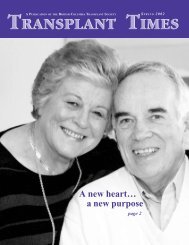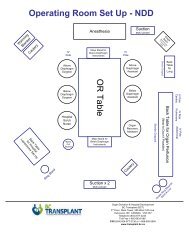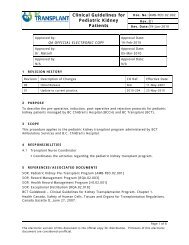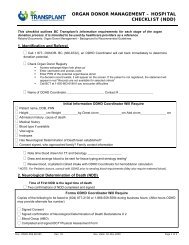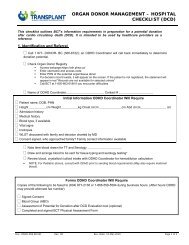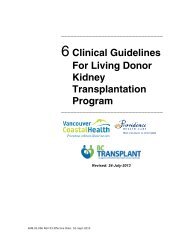4. Clinical Guidelines for Liver Transplantation (PDF) - British ...
4. Clinical Guidelines for Liver Transplantation (PDF) - British ...
4. Clinical Guidelines for Liver Transplantation (PDF) - British ...
You also want an ePaper? Increase the reach of your titles
YUMPU automatically turns print PDFs into web optimized ePapers that Google loves.
<strong>4.</strong><strong>4.</strong>4 LATE COMPLICATIONS<br />
Guidebook <strong>for</strong> the Solid Organ Transplant Programme Chapter 4<br />
Rejection is less common after nine months, although acute rejection can occur at any time<br />
after transplantation. Rejection is almost always confirmed by liver biopsy be<strong>for</strong>e treatment is<br />
instituted. Patients then are treated the same as they are in the immediate perioperative period,<br />
with Methylprednisolone (Solu Medrol ® ), at a dosage of approximately 10 mg/kg IV daily <strong>for</strong><br />
three days. Patients with severe rejection or steroid-resistant rejection may require treatment<br />
with a polyclonal antibody (ATG) IV <strong>for</strong> 7 to 10 days. In addition, they may have their<br />
maintenance immunosuppressive treatment intensified.<br />
CMV infection is common 3 weeks to 6 months after transplantation. Typically, this occurs<br />
in patients who are already CMV positive by CMV PCR testing, as the immunosuppression<br />
decreases the body’s immune surveillance of the virus. Patients may develop generalized<br />
malaise, low-grade fever and often, upper GI complaints. To permit prompt initiation of<br />
therapy, CMV PCR tests are per<strong>for</strong>med routinely according to the CMV Prophylaxis and<br />
Treatment Regimens <strong>for</strong> <strong>Liver</strong> Transplant Recipients (See Appendix I).<br />
These tests are not 100% reliable and diagnosis may have to be confirmed by upper GI<br />
endoscopy or some other method of demonstrating tissue invasion. Patients who are a CMVmismatch,<br />
meaning the donor is positive and the recipient is negative, are at very high risk of<br />
CMV disease.<br />
(See Appendix I: CMV Prophylaxis and Treatment Regimens)<br />
Renal Dysfunction is one of the common complications of long-term immunosuppression.<br />
This is typically associated with calcineurin inhibitors (Cyclosporine and Tacrolimus). Patients<br />
with decreased renal function may need to have their immunosuppressive regime modified.<br />
Those whose serum creatinine continues to rise will be referred to a nephrologist. Occasional<br />
patients may eventually require dialysis.<br />
Hypertension is common after transplantation. This may be related in part to unmasking of<br />
essential hypertension. However, Cyclosporine and Tacrolimus can cause hypertension, partly<br />
through direct effects on blood flow in the kidney. There is a view that calcium channel<br />
blockers may be of benefit, as they cause vasodilatation and preserve renal function. In general,<br />
hypertension in these patients should be treated similarly to that in the non-transplant setting.<br />
Bile duct disease is a common complication of liver transplantation, occurring in up to 15%<br />
of patients. This is typically related to ischemic injury but may be associated with strictures<br />
occurring at the area of anastomosis. Usually patients are asymptomatic and these problems are<br />
detected only on the basis of increasing liver enzymes, however, they may also present with<br />
jaundice or episodes of cholangitis. Rapid identification of the problem is paramount. Patients<br />
require immediate assessment with blood tests, blood cultures and ultrasound. They will often<br />
require an ERCP or percutaneous transhepatic cholangiogram (PTC). Patients with evidence of<br />
biliary tract stenosis may require stenting at the time of the ERCP or placement of a<br />
percutaneous catheter at the time of their PTC. These stents are typically left in place <strong>for</strong> a<br />
period of a few months and exchanged.<br />
Chapter 4 – <strong>Clinical</strong> <strong>Guidelines</strong> <strong>for</strong> <strong>Liver</strong> <strong>Transplantation</strong> – July, 2010 Page 24<br />
See Page 1 <strong>for</strong> disclaimer



